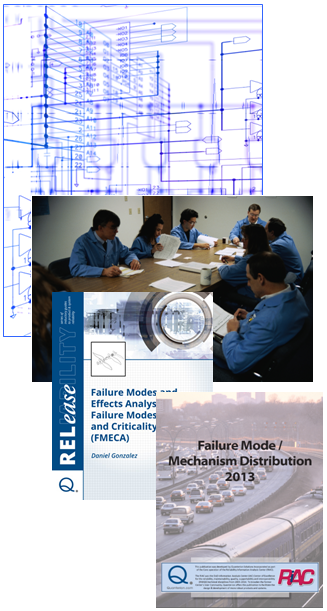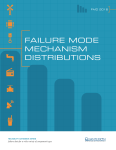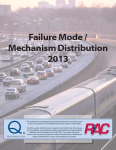| Data & Tools | Publications | Training |
What is it?
A Failure Mode, Effects, and Criticality Analysis (FMECA) is a “bottom up” assessment of the design of a system (hardware, software and/or process) to determine the consequences of a failure on the overall performance or effectiveness of the system. An FMECA can be appropriately tailored and performed at any level, or on any function, of a product/system.
What’s the payoff?
Understanding the consequences of failure is important to safety, maintenance and optimizing reliability. Systematic early identification of the effects of failure (and their criticality) allows design/process corrections before any testing begins. FMECAs also provide valuable information for maintenance manuals and troubleshooting procedures, conserving valuable resources.
How can we help?
- Perform independent FMECAs on your designs and/or processes using various accepted techniques such as SAE or MIL-STD-1629A
- Collect data and build databases of part failure mode/mechanism characteristics for use in FMECAs
- Develop automated FMECA tools customized for your organization’s use
- Objectively review FMECAs performed by third parties and correct any deficiencies
Related Data & Tools:
 Failure Mode / Mechanism Distributions – FMD-2016The 2016 Edition of the Failure Mode/Mechanisms Distribution (FMD-2016) contains field failure mode and mechanism distribution data on a variety of electrical, mechanical, and electromechanical parts and assemblies. This data can be used to apportion an item’s failure rate into modal elements and assist in the performance of reliability analyses and assessments such as Failure Modes, Effects and Criticality Analysis (FMECA) and Fault Tree Analysis (FTA). FMD-2016 contains over 990,000 new records, a 10 fold increase over the 98,000 records presented in its predecessor, FMD-2013.
Failure Mode / Mechanism Distributions – FMD-2016The 2016 Edition of the Failure Mode/Mechanisms Distribution (FMD-2016) contains field failure mode and mechanism distribution data on a variety of electrical, mechanical, and electromechanical parts and assemblies. This data can be used to apportion an item’s failure rate into modal elements and assist in the performance of reliability analyses and assessments such as Failure Modes, Effects and Criticality Analysis (FMECA) and Fault Tree Analysis (FTA). FMD-2016 contains over 990,000 new records, a 10 fold increase over the 98,000 records presented in its predecessor, FMD-2013.
Free Podcast Available! Watch Now!
View Introduction View Part DescriptorsThis product is also offered as a subscription. Click here to view subscription options.*NOTE: The Automated Databook version is not a PDF version of the hardcopy document. The CD-ROM and download versions are Windows compatible database software tools that operate in the Windows environment. The subscription version runs in a web browser and will work on any operating system including Apple MacOS and Linux machines.Contact us at qinfo@quanterion.com for quantities of over 10.
 Failure Mode / Mechanism Distributions – FMD-2013FMD-2013 is the third release in a series of Reliability Information Analysis Center (RIAC) databooks that contain Failure Mode and Mechanism Distribution data. It updates the 1997 Edition of the databook, providing an expanded compendium of failure mode/mechanism data for electronic, electromechanical and mechanical parts, components and assemblies.
Failure Mode / Mechanism Distributions – FMD-2013FMD-2013 is the third release in a series of Reliability Information Analysis Center (RIAC) databooks that contain Failure Mode and Mechanism Distribution data. It updates the 1997 Edition of the databook, providing an expanded compendium of failure mode/mechanism data for electronic, electromechanical and mechanical parts, components and assemblies. QuART PROThe QuART software series represents the fourth generation of the highly popular "Reliability Toolkit" series of RMQ engineering aids originated in 1988 by Quanterion personnel while working at the Rome Laboratory (formerly Rome Air Development Center).
QuART PROThe QuART software series represents the fourth generation of the highly popular "Reliability Toolkit" series of RMQ engineering aids originated in 1988 by Quanterion personnel while working at the Rome Laboratory (formerly Rome Air Development Center). QuART ER (Enhancing Reliability)This 2011 release features over 2 dozen new or improved tools over QuART PRO. QuART ER updates more than 10 tools and adds more than 15 new tools to the tool set available in QuART PRO, including the "Ask a Quanterion Expert" function that allows users to direct their reliability questions to an ASQ certified reliability expert at Quanterion.
QuART ER (Enhancing Reliability)This 2011 release features over 2 dozen new or improved tools over QuART PRO. QuART ER updates more than 10 tools and adds more than 15 new tools to the tool set available in QuART PRO, including the "Ask a Quanterion Expert" function that allows users to direct their reliability questions to an ASQ certified reliability expert at Quanterion.
Related Publications:
 Reliability Toolkit: Commercial Practices EditionThe “Reliability Toolkit: Commercial Practices Edition” helps both the commercial and military sectors deal with developing and manufacturing reliable products in today’s competitive markets. Over 80 topics, representing every aspect of a product’s reliability over its life cycle, have been well received by thousands of Toolkit owners to date.
Reliability Toolkit: Commercial Practices EditionThe “Reliability Toolkit: Commercial Practices Edition” helps both the commercial and military sectors deal with developing and manufacturing reliable products in today’s competitive markets. Over 80 topics, representing every aspect of a product’s reliability over its life cycle, have been well received by thousands of Toolkit owners to date. System Reliability Toolkit-VThe System Reliability Toolkit provides technical guidance in all aspects of system reliability, addressing both software reliability and human factors to better reflect the changing requirements of defense community.
System Reliability Toolkit-VThe System Reliability Toolkit provides technical guidance in all aspects of system reliability, addressing both software reliability and human factors to better reflect the changing requirements of defense community. Effective Application of Software Failure Modes Effects Analysis – 2nd EditionThis book is a practical step-by-step guide for reliability or software engineering practitioners. It illustrates each of the steps for performing a software FMEA and presents dozens of software failure modes and root causes. This book covers the eight possible viewpoints for conducting a SFMEA - requirements, interface design, detailed design and code, vulnerabilities, corrective actions, serviceability, usability and development processes.
Effective Application of Software Failure Modes Effects Analysis – 2nd EditionThis book is a practical step-by-step guide for reliability or software engineering practitioners. It illustrates each of the steps for performing a software FMEA and presents dozens of software failure modes and root causes. This book covers the eight possible viewpoints for conducting a SFMEA - requirements, interface design, detailed design and code, vulnerabilities, corrective actions, serviceability, usability and development processes. Expanded Applications of FMECAThis book expands the discussion of FMECA beyond the realm of the MIL-STD-1629A hardware approach. Commonly-used commercial standards (SAE J1739 and IEC 60812) are introduced. Hardware and Software FMECA (DFMEA), Process FMECA (PFMEA) and Human Systems Integration (HSI)-based PFMECA methods are discussed, with particular attention given to the process, required information, expected results and analysis alternatives.
Expanded Applications of FMECAThis book expands the discussion of FMECA beyond the realm of the MIL-STD-1629A hardware approach. Commonly-used commercial standards (SAE J1739 and IEC 60812) are introduced. Hardware and Software FMECA (DFMEA), Process FMECA (PFMEA) and Human Systems Integration (HSI)-based PFMECA methods are discussed, with particular attention given to the process, required information, expected results and analysis alternatives. Reliability Modeling – The RIAC Guide to Reliability Prediction, Assessment and EstimationThe intent of this book is to provide guidance on modeling techniques that can be used to quantify the reliability of a product or system. In this context, reliability modeling is the process of constructing a mathematical model that is used to estimate the reliability characteristics of a product.
Reliability Modeling – The RIAC Guide to Reliability Prediction, Assessment and EstimationThe intent of this book is to provide guidance on modeling techniques that can be used to quantify the reliability of a product or system. In this context, reliability modeling is the process of constructing a mathematical model that is used to estimate the reliability characteristics of a product. Achieving System Reliability Growth Through Robust Design and TestThis book offers new definitions of how failures can be characterized, and how those new definitions can be used to develop metrics that will quantify how effective a Design for Reliability (DFR) process is in (1) identifying failure modes and (2) mitigating their root failure causes.
Achieving System Reliability Growth Through Robust Design and TestThis book offers new definitions of how failures can be characterized, and how those new definitions can be used to develop metrics that will quantify how effective a Design for Reliability (DFR) process is in (1) identifying failure modes and (2) mitigating their root failure causes. Failure Modes and Effects Analysis (FMEA) / Failure Modes, Effects and Criticality Analysis (FMECA)The FMEA/FMECA is a tool by which a design is analyzed to identify all credible potential ways that the building blocks of a design can fail, and the impact that these failures can have on the product or system. The process begins by identifying the building blocks, then enumerating the functional requirements for each block, and finally listing the effect(s) of failure on both the local and higher-level assemblies until the impacts on the final product or system are projected.
Failure Modes and Effects Analysis (FMEA) / Failure Modes, Effects and Criticality Analysis (FMECA)The FMEA/FMECA is a tool by which a design is analyzed to identify all credible potential ways that the building blocks of a design can fail, and the impact that these failures can have on the product or system. The process begins by identifying the building blocks, then enumerating the functional requirements for each block, and finally listing the effect(s) of failure on both the local and higher-level assemblies until the impacts on the final product or system are projected.
 Lunchtime Learning SeriesThe “Lunchtime Learning” series is a group of short course tutorials are aimed at providing a basic introduction to a variety of topics in which our community members have expressed an interest.
Lunchtime Learning SeriesThe “Lunchtime Learning” series is a group of short course tutorials are aimed at providing a basic introduction to a variety of topics in which our community members have expressed an interest.
Related Training:
 Failure Mode, Effects and Criticality Analysis (FMECA) and Fault Tree Analysis (FTA)FMECAs and FTAs are popular methods for determining the impact of failures on the product or system. This module focuses on these two popular approaches to system logic analysis.
Failure Mode, Effects and Criticality Analysis (FMECA) and Fault Tree Analysis (FTA)FMECAs and FTAs are popular methods for determining the impact of failures on the product or system. This module focuses on these two popular approaches to system logic analysis.

